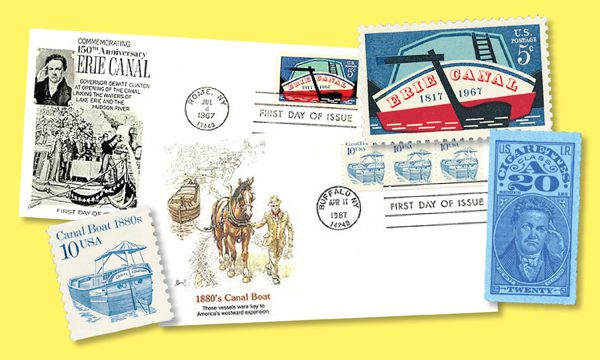Opening of the Erie Canal

On October 26, 1825, the Erie Canal opened, offering a quicker shipping route through New York’s waterways.
In the early 1800s, sending goods west from New York City across the state was expensive and took a lot of time. There were no railroads yet and it took two weeks to travel by stagecoach. Several New York legislators proposed the idea of building a canal across the state, and they received tremendous support from Governor DeWitt Clinton.

Clinton had served as a delegate to the New York State Constitutional Convention, a US Senator, and mayor of New York City before being elected governor in 1817. While in office, he pushed for the construction of the Erie Canal to connect the upper Hudson River to the eastern shore of Lake Erie.

Clinton convinced the legislature to supply $7 million for this project. His opponents thought the canal was impractical and named it “Clinton’s Ditch.” Clinton’s proposed canal would be 363 miles long, 40 feet wide, and four feet deep. Construction on the canal began on July 4, 1817, in Rome, New York (just 18 miles from Mystic’s home in Camden, New York). The first 15-mile section (stretching from Rome to Utica) opened in 1819.
After more than two years of digging, the 425-mile Erie Canal officially opened on October 26, 1825. Clinton, who had planned the canal’s design and supervised its construction, played a major role in the opening ceremonies. That day he boarded the Seneca Chief in Buffalo and traveled the full length of the canal, then the Hudson, all the way to New York City.

As part of the ceremony, cannons were set up along the entire length of the river, within hearing distance of each other. As Clinton left Buffalo, the first cannon was shot off, which signaled the next one to fire. Cannons boomed the message all the way to New York City within 90 minutes, the fastest communication of the time.
Clinton arrived in New York City on November 4. Upon arrival in New York Harbor, he emptied two small barrels of water from Lake Erie into the harbor to signify the joining of the two bodies of water.
The Erie Canal was successful from the start. It was much faster to transport goods up the Hudson River and through the 36 locks of the canal than to travel by land, and it cost about 95% less. The canal opened the West to settlement and trade and gave Midwest farmers an economical way to get their grain to market. New York City became the largest port city in the United States, and the population of New York State increased dramatically along the canal route.

The critics of DeWitt Clinton were silenced when the importance of the canal to the country was realized. Some consider Clinton an unsung American hero.

Click here to visit the Erie Canalway National Heritage Corridor website.
Click here to see what else happened on This Day in History.

Thanks Mystic for another great read. I passed by parts of the canal on my visit to Cooperstown and plan on going back to explore some of the history of the canal. DeWitt Clinton was a visionary who was successful in leading New York State through some of its early growth.
And with the completion of the Ohio Canal connecting Lake Erie to the Ohio River it
made a complete water route form New York City to St. Louis and New Orleans.
Thank you for a great piece of history. Me being in Kansas never dreamed of how the cannel came about. I heard songs and heard about the cannel but it was never presented as you did. Thank you for bringing it to light.